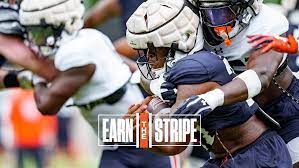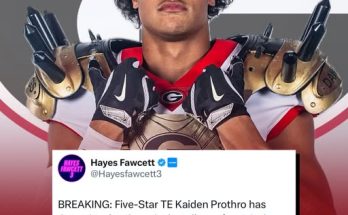The recent opening at Baylor University has introduced an unexpected twist into the dynamics of college football as the 2025 season approaches, with ripple effects already beginning to influence programs far beyond Waco, Texas. One program feeling the tremors most directly is Auburn University, whose fall camp could take on a dramatically new complexion in light of this development. While coaching changes and staff openings are not unusual during the summer months, the timing, nature, and potential implications of this particular vacancy are already prompting key shifts in recruiting strategies, staff focus, and even on-field priorities for programs like Auburn. At first glance, it might seem odd that an opening in the Big 12 would so directly impact an SEC powerhouse like Auburn, but upon closer inspection, the strategic overlap in recruiting territory, coaching philosophies, and long-term program goals makes the connection not only plausible but potentially pivotal.
The context of this shift starts with Baylor’s status as a strong but recently fluctuating program. With their coach either stepping down, moving on, or being dismissed—depending on which insider reports you believe—the Bears have entered a period of transition. This creates a temporary vacuum not just in leadership but also in the competitive recruiting ecosystem of Texas and surrounding states. Auburn, under Head Coach Hugh Freeze, has been steadily expanding its recruiting footprint beyond the Deep South, with Texas increasingly becoming a territory of interest. The opening at Baylor thus presents an opportunity for Auburn to exploit instability in the region to recalibrate its recruitment strategy, particularly for the 2025 and 2026 classes.
High school athletes, particularly top-tier prospects, are often deeply influenced by the stability and clarity of a program’s coaching staff. Baylor’s sudden instability might cause some committed or interested recruits to reevaluate their choices. In turn, Auburn’s coaching staff could seize the moment to reinforce their pitch to recruits who might have been leaning toward Baylor but are now uncertain. With proper timing and the right message, Auburn can present itself as a model of comparative stability and upward momentum. The Tiger staff can point to Freeze’s offensive philosophy, the SEC’s competitive prestige, and Auburn’s recent investments in facilities and program development. In the eyes of recruits—especially those from Texas or neighboring areas who had Baylor on their radar—this may significantly enhance Auburn’s appeal.
However, the implications of Baylor’s opening aren’t just about flipping recruits. There’s also the question of coaching movement and how Auburn’s internal dynamics might shift as a result. Anytime a Power Five job opens up, particularly one with as much history and potential as Baylor’s, the college football coaching carousel begins to spin faster. Assistant coaches from around the country, including those at Auburn, may now find themselves on watchlists or candidate shortlists for potential Baylor hires. This means Freeze and his staff will need to prepare for possible departures—either immediately or at the end of the season—and start considering contingency plans. Whether it’s coordinators or position coaches, any potential staff loss or interview distraction could impact the cohesion of Auburn’s fall camp, especially during critical install periods and player development phases.
On the flip side, if Auburn’s staff remains intact, Baylor’s situation could present an opportunity for Freeze to tweak or elevate his own coaching strategies. For instance, if a top offensive or defensive mind from another program heads to Waco, Auburn could use the resulting ripple effects to poach an up-and-coming coordinator or analyst. More interestingly, Auburn may use the moment as a catalyst for internal reflection. If Baylor’s coaching opening leads to an arms race in innovative offensive schemes or defensive philosophies within the Big 12 and SEC crossover areas, Freeze and his analysts may preemptively evolve their own playbooks to stay ahead of the curve. It’s often during such transitions at peer institutions that programs take stock of their own trajectory and make bold strategic pivots.
This kind of strategic evolution could play out during fall camp, where new play concepts, experimental formations, or developmental shifts for key players are easier to test before the season begins. For example, Auburn might take advantage of the added recruiting attention to showcase a more aggressive offensive identity during practices—footage and whispers of which could trickle back to recruits still on the fence. If key Texas-based targets sense that Auburn is both stable and creatively dynamic, the allure increases further. The Tigers could also increase focus on developing younger depth players in fall camp in anticipation of landing more elite talent from regions previously dominated by Baylor and its Big 12 allies.
It’s also worth noting the psychological component for Auburn’s existing roster. Players are not blind to the realities of the coaching profession. They know staff members have aspirations and that every opening creates opportunities and uncertainties. How Coach Freeze communicates with his team during this time can have a strong impact on locker room unity and focus. If he’s transparent about potential changes while reinforcing the commitment and identity of the current program, he can turn the external disruption into a galvanizing internal force. Veterans and team leaders can help drive the message: we control what we can control, and every moment on the practice field counts.
Recruiting-wise, Baylor’s opening gives Auburn an opening to press harder in central Texas, Houston, and even parts of the Dallas-Fort Worth metroplex. Auburn has already been pushing into these areas thanks to changes in NIL dynamics and broader recruiting networks, and now the door is ajar to do so more aggressively. The Auburn staff may send more representatives to Texas high school games, build deeper relationships with local coaches, and find new inroads to blue-chip talent who are suddenly reconsidering their options. While it’s impossible to predict how Baylor’s hiring process will unfold, the uncertainty itself can be leveraged. Any delay in hiring or ambiguity around the new coach’s philosophy can play to Auburn’s advantage—especially if Freeze continues to pitch himself as a developer of both quarterbacks and people, a point he often emphasizes.
Furthermore, Auburn can turn the instability at Baylor into a subtle but powerful marketing point for recruits and transfers alike. With the transfer portal becoming a critical part of roster building, a player who might have considered Baylor in a prior cycle could now be more open to Auburn if the messaging and development pitch is strong. The coaching staff can increase visibility through media appearances, social content, and behind-the-scenes footage of fall camp—all aimed at projecting confidence, clarity, and momentum. Every detail matters, from how structured the practices look to how coaches interact with players, and Auburn will be wise to choreograph their fall camp to reflect professionalism and excitement.
From a tactical standpoint, Auburn may also use this opportunity to prepare for a broader range of potential competition scenarios. If Baylor’s new coach is known for a particular style—say, tempo-heavy offense or aggressive blitzing defenses—Auburn may begin prepping for those trends early in the season as part of their national scouting efforts. This matters not just for potential matchups but for overall awareness of where the game is evolving, especially since SEC and Big 12 programs often compete for the same bowl games, playoff spots, or television attention.
Another critical area impacted by Baylor’s opening is Auburn’s internal staff development and retention planning. As other programs eye Auburn assistants for potential hiring, Freeze might be prompted to solidify retention strategies—offering promotions, new titles, or increased responsibilities to keep key figures in place. This could lead to a fall camp dynamic where younger staff members take on more visible roles, perhaps preparing them for larger duties in the future. It’s an underappreciated aspect of team development but a crucial one: staff chemistry and continuity are often as important as player execution on the field.
In the broader scope of the college football landscape, Baylor’s opening is not just a vacancy—it’s a signal that the chessboard is shifting. Auburn, being one of the more nimble and strategically aggressive programs in the SEC, is positioned to turn that signal into an advantage if it plays its cards right. Whether through recruiting gains, coaching strategy upgrades, or player development realignments, the ripple effects of one job opening can, and often do, cascade into changes across the country. And when the dust settles in Waco, it may be that Auburn emerges a few steps ahead—not just in Texas recruiting battles but in national positioning for a playoff push.
As fall camp gets underway, the Tigers will be watching Waco closely—but not with concern. Rather, they’ll be watching with intent. Because in the high-stakes world of college football, the program that adapts fastest to opportunity often wins the season before the first whistle ever blows.



